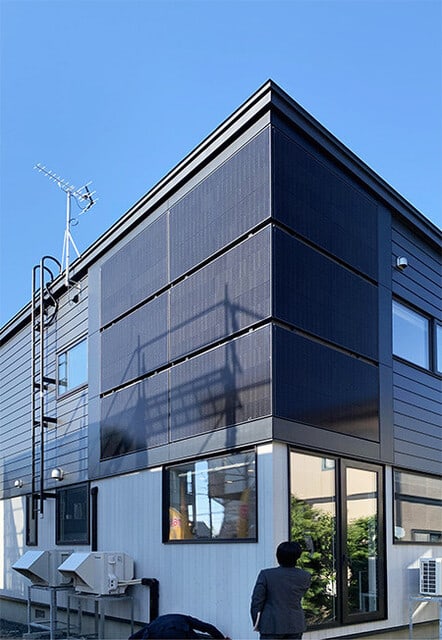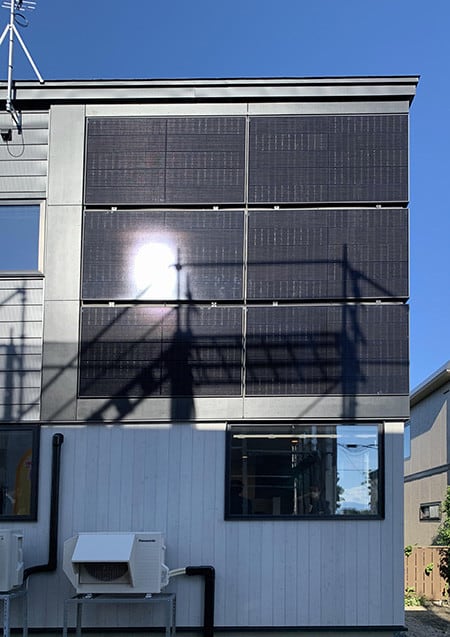

さて寒冷地での太陽光発電ハンディキャップについての事例チェック。
東京都の「義務化」の動向が大きな論議を呼んでもいますね。寒冷地では
屋根面はおおむね12月から3月までの積雪期間では効率ダウンが避けられない。
温暖地域と比べこういう自然気候条件での「格差」は否定しようがない。
不安点としてさらに積雪荷重による破損などの不安もあって
寒冷地のビルダーにとっては判断が難しい部分がある。
この点、気候要素を勘案しての国民への平等性確保の対応を政府に期待したい。
しかし、建て主の電気代メリットを考えると導入手法を探究する必要はある。
たとえフル稼働が9〜10ヶ月だとしてもトータルとしては有利。
電力各社も節電対策もあって太陽光+蓄電という設備セット組み込みの
料金プランを用意しはじめて来ている。
どうやったらそのハンディキャップを乗り越えられるのか、について
札幌のビルダーのひとつの挑戦事例として「壁面設置」作戦があります。
先日、久しぶり、3年ぶりくらいに新住協札幌支部での
「現場見学会」が実施されました。
そのなかで注目していたのが地元の藤城建設さんのモデルハウス見学。
藤城さんは高断熱高気密住宅の規格住宅化でコストメリットを引き出す一方
こうした太陽光発電利用でも積極的に取り組んできている。
すでに数年前から写真のような「壁面設置」を推進している。
このモデルハウスでは屋根面にもこの壁面以上に多く設置しているので、
こちらは「サブ」という扱いですが、
家全体トータルで10k以上の発電を実効させているということ。
発電効率は屋根面設置に対し「おおむね95%程度」のランニングという。
長期での安定設置を考えて設置方法には工夫がされている。
壁面構造下地との緊結を注意深く施工すると同時に
他の壁面と「面を合わせて」いる。
千変万化する風による影響を低減化させています。
売電による家計収入メリットも本州以南地域とほぼ遜色ないレベルとのこと。
屋根面については積雪荷重による障害の不安が問題になるでしょうが
現状ではことしの冬のような大雪でも問題はなかったということ。
今後、より詳細なチェック取材をしたいと思っています。
さらに壁面設置の場合、隣家などへの「キラキラ光」ご迷惑が心配ですが、
パネルの種類選択でごらんのように反射光が押さえられたものを採用。
種類選択で価格が高額になることはないとされていました。
壁面設置の場合、考えられる設置方向は南面と西面とのこと。
このモデル住宅では西面の方により多く設置している。
やはり室内へ光を取り入れるには南面はより窓位置として重要。
対して西面利用は北海道は本州地域と比べ高緯度なので合理的といえる。
このような状況を見てみると、あとはデザイン的な問題か。
建築時の採光法令基準条件との見合いも含めて
窓の開口位置と太陽光パネルの配置バランス、
室内の間取り計画との整合性が問われてくることになる。
近隣関係での相互信頼の確保も重要になってくるともいえる。
こういった先行事例は多くの示唆に富んでいると思います。
English version⬇
Solar panel "wall installation" in Sapporo
Tokyo's "mandatory installation" has been the subject of much debate. Cold regions are at a disadvantage in terms of climate. However, the wisdom and ingenuity of the "advanced region on the issue" are also present. ・・・・・.
Now a case check on the solar power handicap in cold weather.
Tokyo's "mandate" trend is also very controversial. In cold regions
Roof surfaces are generally snow-covered from December to March, and a reduction in efficiency is inevitable.
There is no way to deny the "disparity" in these natural climatic conditions compared to warmer regions.
In this regard, we hope that the government will take climate factors into consideration to ensure equality among citizens.
There are also concerns about damage due to snow loads.
This is a difficult decision for builders in cold regions.
However, it is necessary to explore the introduction method considering the electricity cost advantages for builders.
Even if full operation lasts for 9 to 10 months, it is advantageous in total.
Electric power companies are also beginning to offer rate plans that incorporate solar power + electricity storage as part of their electricity conservation measures.
The electric power companies are also beginning to offer rate plans that incorporate both solar power and electricity storage as a set of facilities.
How can we overcome this handicap?
One example of a challenge by a builder in Sapporo is the "wall installation" strategy.
The other day, for the first time in a long time, about three years, the Shinjyukyo Sapporo Branch
The local Fujishiro office was the focus of attention.
One of the highlights was a visit to a model house built by a local company, Fujiki Construction.
Mr. Fujishiro has been actively working on the use of solar power generation and has been able to bring out cost advantages through the standardization of highly insulated and airtight houses.
Mr. Fujishiro has also been actively working on the use of solar power generation.
For several years, he has been promoting "wall-mounted" solar power generation, as shown in the photo.
In this model house, we have installed more on the roof surface than on this wall.
This one is treated as a "sub.
The total power generation of the entire house is effectively more than 10k.
The power generation efficiency is said to be "about 95%" of that of a roof-mounted system.
The installation method has been devised to ensure stable installation over the long term.
Careful construction of the wall structure base and bonding
The wall surface is "flush" with the other wall surfaces.
The effects of wind, which can change in a thousand different ways, are reduced.
The household income benefit from the sale of electricity is also at a level that is almost equal to that in areas south of Honshu.
As for the roof surface, there will be a problem with the anxiety of failure due to snow load, but the current situation is that the roof surface will not be damaged by the snow.
However, there have been no problems even with heavy snowfalls such as this winter's.
We would like to conduct a more detailed check in the future.
Furthermore, we are concerned about the "sparkling light" inconvenience to the neighbors when the panels are installed on the wall, but we are not sure if this is a problem.
However, as you can see, we selected a panel type that suppresses reflected light.
However, as you can see, the panels are designed to suppress reflected light, and the price is not too expensive.
In the case of wall installation, the possible installation directions are the south and west faces.
In this model house, they are installed more on the west side.
After all, the south side is more important as a window position to bring light into the room.
In contrast, the use of west-facing windows is more reasonable because Hokkaido is located at a higher latitude than the Honshu region.
Looking at the above situation, the rest is a matter of design.
(including the consideration of the lighting code requirements at the time of construction).
The balance between window openings and solar panel placement, and
The consistency with the interior floor plan will be a question to be answered.
It is also important to ensure mutual trust in neighborhood relations.
I believe that these precedents are rich in suggestions.










